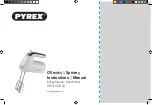
2
Chapter 1—Welcome
DME32—Owner’s Manual
Welcome
Thank you for choosing the Yamaha DME32 Digital Mixing Engine.
The DME32 Digital Mixing Engine and DME Manager software allow sound-system
installers to custom build systems to meet the specific requirements of almost any
installation. Entire systems from input through to output can be designed using DME
Manager and then transferred to the DME32, which can then be used as a standalone
processor. Typical applications include installed sound systems, submixing, loud-
speaker system controllers, matrix/routing, and multi-effects processing.
The DME32 in a Nutshell
DME32 audio systems, or configurations as they’re known in DME32 terminology, are
built in an intuitive “block diagram” style using Yamaha’s dedicated DME Manager
software. Building configurations consists of adding the necessary components, wiring
them together, compiling, and then transferring that information to the DME32, using
either RS232/RS422, USB (Universal Serial Bus), or PC Cards.
Once programmed, the DME32 operates as a standalone processor and the PC can be
disconnected, although it can be connected permanently in applications where
real-time control from DME Manager is desirable. Even then, if the PC connection is
lost for some reason, the DME32 just keeps on going.
Components form the building blocks in configurations. Some components are com-
plete audio processors, such as mixers, compressors, effects, and crossovers, while oth-
ers are individual parts, such as faders, switches, pan controls, and meters. System
designers can create their own custom components using the User modules.
DME Manager operates in one of three modes: Edit, Cable, or Run. Edit mode is used
mainly to build and edit configurations, although it can also be used to edit and preview
scenes offline. Cable mode is for wiring components together. Run mode is used to con-
trol the DME32 system in real time, which includes editing component parameters,
storing and recalling scenes, and recalling configurations. In Run mode, actions per-
formed on DME Manager are reflected on the DME32 and vice versa.
The DME32 can store two configurations: A and B. Additional configurations can be
stored on PC Cards. Each configuration can store up to 99 scenes, or snapshots of every
component parameter setting in the configuration. Configurations and scenes can be
recalled from the DME32 front panel, DME Manager, MIDI, or the GPI interface. Con-
figurations and scenes can be titled from the PC keyboard for easy identification.
When operating as a standalone processor, various DME32 functions can controlled
from the front panel, including editing component parameters, storing and recalling
DME
Manager
32 outputs
32 inputs
Control
SCENE NO.
CONFIGURATION
48kHz
LOCK
EMERGENCY
44.1kHz
SCENE
COMPONENT
PARAMETER
UTILITY
VALUE
CARD
USER DEFINE
PROTECT
INC
DEC
DIGITAL MIXING ENGINE
POWER
ON
OFF
7
8
9
4
5
6
1
2
0
STORE
RECALL
3
SCENE RECALL
DATA
X
Digital
X
Mixing
X
Engine
XXXXX
YAMAHA
X
DME32
88












































